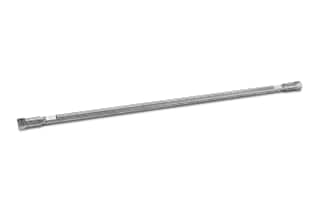
Primarily supports legacy methods. BioSuite SEC Columns are available in 4.6 mm, 7.5 mm, and 7.8 mm i.d. analytical and 21.5 mm i.d. preparative and guard columns.
|
Chemistry |
Diol (OH) |
|
Separation Mode |
SEC |
|
Particle Substrate |
Silica |
|
pH Range Min |
2.5 pH |
|
pH Range Max |
7.5 pH |
|
Maximum Pressure |
1800 psi (124 bar) |
|
Endcapped |
Yes |
|
Molecular Weight Range Min |
10000 |
|
Molecular Weight Range Max |
500000 |
|
Particle Shape |
Spherical |
|
Particle Size |
4 µm |
|
Endfitting Type |
Parker-style |
|
Pore Size |
250 Å |
|
Format |
Column |
|
System |
HPLC |
|
USP Classification |
L59 |
|
Inner Diameter |
4.6 mm |
|
Length |
300 mm |
|
UNSPSC |
41115709 |
|
Application |
Protein |
|
Brand |
BioSuite |
|
Product Type |
Columns |
|
Units per Package |
1 pk |
BioSuite Diol (OH) Column, 250Å, 4 µm, 4.6 mm X 300 mm, 10K - 500K, 1/pk
Waters’ BioSuite family of columns is designed to provide high-performance chemistries for those performing isolation, analysis, and characterization of biomolecules in HPLC separations. Designed to meet the demands of challenging protein and peptide analysis, the BioSuite Diol (OH) Column offers maximum separation efficiency. This column uses a wettable, silica-based material that is rigid enough to give chemical stability across a pH range of 2.5 to 7.5. The length and particle size of this column further increases separation efficiency.
The BioSuite Diol (OH) Column’s chemistry makes it the optimal lab equipment for chromatographers performing isolation, analysis, and characterization of proteins and peptides. The column can be used to determine the resolution and recovery of proteins and peptides, yielding reliable results by adequately characterizing complex biomolecules, allowing for the successful development of protein-based biopharmaceuticals and diagnostic reagents. The orthogonal separation techniques of the BioSuite Diol (OH) Column allow for chromatographers to produce next-generation drugs, helping to provide critical characterization data and isolated material required for this task.
Each column is tested against narrow specifications in order to meet industry standards and provide reproducible results. In order to maintain this performance and ensure longer column lifetimes, a BioSuite Diol (OH) Guard Column, 5 µm, 6 mm X 40 mm, 1/pk can be added. This can prevent constant replacements, as it has been designed specifically to work with the BioSuite Diol (OH) Column, offering protection from any mobile phase contamination.
Are Proteins And Peptides The Same Thing?
Peptides and proteins are often referenced together, but they are not the same thing. Both are made up of strings of amino acids and are held together by peptide bonds. However, peptides are made up of smaller chains of amino acids than proteins. The general rule is that a peptide contains two or more amino acids, though the term polypeptides can also refer to a chain of 10 or more amino acids. Protein usually refers to large peptide molecules, which can be either one long chain of 100 or more amino acids, or a composition of several amino acid chains joined together. Hemoglobin would be an example of these larger proteins.